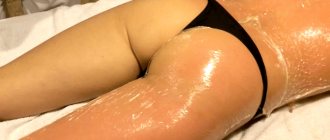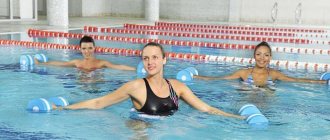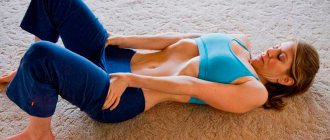Good day, dear readers. The summer season is over and most women have left dieting behind. On the one hand, it is true: vacation is only in a year, the swimming season is closed, and all figure flaws can be hidden under thick clothes.
But is it really not a pity for the results that women persistently achieved with blood and sweat? Are they really ready to regain all those kilograms that left their body a couple of months ago? Definitely not, and of course I want to maintain the results obtained, and some even in the hope of improving it. And today I will tell you how water aerobics for weight loss will help you achieve this.
Ask yourself a question: what if the vacation is not in a year, as planned, but, for example, in the winter? Then you will have to expose your body again in order to enjoy it to the fullest. In this case, we need to start preparing for the summer-winter season now.
I looked at the services of fitness centers and health centers: they mainly offer strength training and stretching. But all this is more suitable for young people who do not have diseases. Therefore, the choice fell on water aerobics.
Water aerobics is rhythmic movements on the water. It involves performing a set of exercises and has a number of attractive aspects, which I will write about below.
What is water aerobics
There is nothing incomprehensible about ordinary aerobics or fitness classes in the gym; there are a huge number of videos and photos with training results. However, not everyone likes to go to the gym, carry iron or sweat on the treadmill. This is where the question arises: is it possible to lose weight through water aerobics? The pool and water are a wonderful atmosphere for all people who love to swim. Water aerobics is a special set of exercises that is performed in water. Small weights may be used or the workouts may be performed using only body weight.
Water aerobics for weight loss has its own characteristics, which become a decisive factor when choosing a method for maintaining the health of the body and getting rid of extra pounds. This sport will be an excellent choice for people who:
- love group activities where you can socialize;
- cannot bring themselves to exercise at home and need a specific training program;
- want to lose weight while listening to music;
- they love water, but do not know how to swim: special belts are used during classes;
- they want to swim, but they are tired of simple swims in the pool.
Such workouts are useful not only for those who want to lose weight, but also for people who want to strengthen their immunity and keep their muscles in good shape. The results of the exercises will be noticeable, especially if you follow a diet and get a good night's rest. You should exercise regularly, because only systematic training will give noticeable results.
What should be the diet when doing water aerobics?
It is worth understanding that an integrated approach is very important to solve the problem of excess weight. If you fight extra pounds with one diet, you will have to wait a long time for results. In addition, most likely, such weight loss will leave stretch marks and sagging skin as a “memento.” The same goes for training. Without changing your eating habits, you will simply strengthen your muscle mass, but the subcutaneous fat will remain in place. That is why to successfully lose weight you need not only to play sports, in this case it is water aerobics. Eating before and after training should be healthy.
The body receives the vast majority of all useful substances for stable functioning directly from the food consumed. Accordingly, it is important to ensure a diet in which you receive a maximum of these substances and a minimum of calories that are converted into fat. This is actually quite simple to do, but you will always have to carefully study the energy value of each product included in your menu.
If we talk about truly rational nutrition, we can highlight the following basic principles of food consumption:
- maintaining a balance between energy expended and energy received from food;
- meeting human needs for a specific amount of nutrients, as well as their correct ratio;
- timeliness of all meals (meals should take place every day at the same time).
However, even with strict adherence to the above rules, quite often it is not possible to achieve any results in weight loss. It is generally accepted that obese people abuse high-calorie foods. However, the statistics are truly surprising: this is absolutely not true! In fact, only 20% of overweight people consume too many calories (over 2,800 per day). Another 40% eat moderately (about 1800-2700 kcal per day), and the remaining 40% eat very little - from 800 to 1500 kcal per day. What explains such seemingly illogical data?
What can you eat after water aerobics? Think about the true meaning of food. Change your attitude towards her! If you treat food as a banal physiological need, most likely your nutrition will be incorrect, and this can not only lead to obesity, but also increase the risk of developing many diseases. Many people are familiar with the situation when they have to snack on the go, because they simply don’t have time for a full lunch. And sometimes this meal is completely skipped due to being overwhelmed at work. As a result, a person comes home and has a hearty dinner, often not denying himself unhealthy and high-calorie foods. Of course, this approach to nutrition is clearly not beneficial to your health or figure.
Pros and cons of water aerobics
The main advantage of this sport is that there is no load on the spine or joints. This allows you to train even for people who are contraindicated for strength exercises and expectant mothers. The pros and cons of water aerobics should be found out before going to the pool. First you need to visit a doctor who will confirm that water procedures are not contraindicated for you (for example, if you have problems with the genitourinary system). You can understand whether water aerobics helps you lose weight by looking at the following advantages of this type of training:
- the lowest probability of injury to tendons, ligaments, bones or muscles;
- a variety of exercises that help you lose weight without boredom;
- the absence of stress on the back and lower back opens up the opportunity for pregnant women and people with injuries to train;
- in one water aerobics workout, a person burns up to 700 calories;
- while you are exercising, your body will not sweat;
- training in water strengthens all muscle groups;
- If necessary, you can increase the load using special devices;
- water aerobics classes are effective against cellulite and excess weight;
- training in water helps normalize sleep and get rid of stress;
- Even those who cannot swim can burn extra pounds this way.
The benefits of this method of losing weight are what make water aerobics classes so popular. The disadvantages include only a few points, for example, the likelihood of an individual allergy to bleach. This substance is actively used in swimming pools to prevent the development of microorganisms and protect the health of visitors. Some people experience skin irritation, eye irritation, and in extreme cases asthma attacks.
Failure to comply with the rules of conduct during water aerobics training may result in an exacerbation of ear diseases. This sport is just gaining popularity, so the cost of classes is still high, but you can save money by purchasing a subscription. Smaller pools will have a lower price, and elite fitness clubs also charge for the brand. Keep in mind that losing weight, strengthening muscle tone, and getting the maximum effect can only be achieved by training with a qualified trainer.
- Crafts from matches
- How to cook frozen peeled mussels
- What foods contain large amounts of vitamin E?

What should be the diet when doing water aerobics?
Is it possible to eat after water aerobics? What should you eat after water aerobics? Read this and much more below in order to gain a slim and toned body:
- After training, give preference to protein foods (dairy and soy products, meat, fish and poultry) for another 18 hours;
- do not eat anything 2 hours before classes and for the first 3 hours after;
- if there is no tendency to edema, consume water in unlimited quantities;
- on days when there are no workouts, you should not eat anything after 7 pm;
- the most important meals of the day are breakfast and lunch;
- limit sweets as much as possible in your diet;
- replace your usual white bread with black bread if you have no contraindications to its use;
- reduce your consumption or completely give up mayonnaise, alcoholic beverages, everything salty and spicy, as well as coffee (no more than 1-2 cups per day are allowed);
- include more food of plant origin (greens, fruits, vegetables) in your menu; use vegetable oil for cooking;
- give preference to liver, poultry and fish, but refrain from fatty meats;
- eat less fried food;
- on training days, other types of physical activity, as well as visiting the sauna, are undesirable;
- to ensure proper digestive processes, it is better not to combine meat with rice (vegetables are ideal);
- Consume dairy products separately from other foods, as they are practically incompatible with anything.
These dietary recommendations do not apply to people who have been prescribed a special therapeutic diet by their doctor. But for healthy people they will only be beneficial and will help increase the effectiveness of training in the pool.
The benefits of water aerobics
The ability to lose weight is not the only advantage of exercising in water. The benefit of water aerobics is that you can make your figure slim without working with weights. Staying in water improves your mood, helps get rid of negative energy, and normalizes sleep. According to reviews from girls, with the help of such water gymnastics you can get rid of the belly after childbirth, cellulite and simply improve the condition of the skin. During water aerobics the following are involved:
- shoulders;
- abs and sides;
- buttocks;
- breast;
- hands;
- hips.
How water aerobics helps you lose weight
Water aerobics, also known as water aerobics or aquatic exercise, is a group cardio workout that is usually performed in the shallow water of a swimming pool or with special floats and additional floatation equipment in deeper water.
The resistance of the water that you experience during such a workout forces your entire body to work. Exercising in water will help you develop muscles and burn more fat.
Sometimes water aerobics classes include strength training using floating weights, which also helps tone and shape your body.
What benefits does water aerobics give to the body?
- Improves endurance.
Research shows that after 12 weeks of regular aquatic exercise, participants experience significant gains in muscle strength, flexibility and endurance.
- Increases muscle strength.
The resistance of pool water varies from 4 to 42 times that of air, providing a serious challenge to your muscles.
- Increases flexibility.
The body is exposed to water flow during exercise. In this case, movements occur in different directions, and the joints increase the range of motion naturally.
- Relieves pressure on joints.
The density of water helps relieve some of the effects of gravity, making our bodies less susceptible to gravity. Therefore, the effect on joints in water is significantly weakened compared to training on land.
This is especially important for people who suffer from arthritis or are undergoing physical rehabilitation after an injury.
- Relieves stress and reduces anxiety.
Watching the movement of water is recognized as one of the most calming activities, which is why spending time at the beach is such a popular holiday.
Studies have shown that water training significantly reduces anxiety and depression.
- Burns calories.
The combination of exercises combined with water resistance provides the body with a complete workout. Depending on the intensity of movement, the use of dumbbells or weights, and the temperature of the water, the body can burn from 400 to 500 calories per hour of water aerobics.
- Lowers blood pressure.
The effect of water is not only on the muscles, but also on the circulatory system, allowing blood to circulate more efficiently throughout the body, reducing blood pressure and heart rate. This has a positive effect on the functioning of the heart.
Water aerobics for weight loss is said to help lift spirits and provide social interaction in a group setting. It is one of the most popular forms of physical activity and is not limited to any age group or fitness level.
Water aerobics for weight loss
All a person needs to do is repeat the exercises after the trainer. The benefit of water aerobics for weight loss is that no additional means are needed (sports supplements, magic teas, etc.). Losing excess weight will occur due to proper nutrition and the exercise you receive in classes. The following factors help you lose weight in water:
- Muscles work actively due to the resistance that the body encounters in the water during movements.
- The water temperature is always lower than human temperature, so the body begins to release additional energy for heating and excess fat deposits are burned.
- Water aerobics speeds up the metabolism in the human body.
- In one intensive session in the pool you can lose 500-700 kcal. An athlete who participates in a high-speed ski race loses the same amount.
Is it possible to lose weight by doing water aerobics?
Fitness instructors claim that it is really possible to lose weight, because during a workout you can burn from 140 to 240 kcal. Calculations depend on your height, age, weight, load and duration of training.
However, if you compare water aerobics with other types of anaerobic activity, then this method is not at the top of the list of “How to lose weight quickly?” Running, swimming in different styles and even dancing will burn from 200 to 400 kcal per workout. Therefore, if you need results as soon as possible, then you should not stop at water aerobics. It is better to consider this method as an additional one to your weekly training program schedule and combine it with strength and cardio exercises in the gym.
If you decide that you want to do exclusively water aerobics, then to keep your body in shape you need to visit the pool 2-3 times a week, and to lose weight - at least 5 times. At the same time, be sure to control your diet. You can choose a diet where everything will be strictly scheduled by the hour, or calculate the daily calorie intake for weight loss and create a menu yourself. Doctors do not recommend following a low-carbohydrate diet, because with frequent exercise, the body requires quick energy, especially at the beginning, when the body has not yet learned to release energy from fat deposits.
In general, if you maintain a calorie deficit in your diet and regularly do water aerobics, you can see results after the first month of training.
Water aerobics exercises for weight loss
Before any sport activity, it is necessary to warm up. Water will prevent injury, but you need to warm up your muscles. Exercises should be performed in the air: several bends to the sides, forward and backward, do 10-15 squats, rotational movements with your arms. Next, you can perform water aerobics exercises for weight loss:
- For the waist. Clasp your hands near your chest (they should be under water), press your elbows to your stomach. Bend your body in all directions one at a time.
- Hips, belly. Find an area in the pool so that the water is at chest level when you sit on the bottom. Place your hands behind you, swing your legs down and up, then perform “scissors” (cross swings).
- Legs. Spread your feet hip-width apart and you should be shoulder-deep in the water. Perform a jump and at this time bring your legs together and spread them again until you land on the bottom.
- Buttocks. Stand at the handrails, grab them with your hands, keep your back straight, move one of your legs as far back and up as possible. Repeat for each 10-15 times.

What does the lesson consist of?
As I said earlier, water aerobics is not one exercise, but a whole complex that involves all parts of the body.
During the class, instructors give exercises designed to help you lose weight in the following areas:
- Belly;
- Hips;
- Buttocks.
From my personal sports collection, I will share a couple of exercises that are used in all water aerobics programs that promote weight loss.
Abdominal exercises
- Place your feet shoulder-width apart and start jumping, turning your body alternately to the right and then to the left. The hips should remain motionless.
- The exercise should be performed in 2 sets of 30 times in each direction.
- Go to the wall of the pool and press your back against it. Place your elbows on the side. Bend your knees and begin to lift, trying to bring them as close to your chest as possible. Your back should remain pressed against the wall of the pool.
The exercise costs 3 approaches, 10 times each.
If you feel that this load is no longer enough for the body, repeat the exercise, but with straight legs.
Leave the number of approaches and repetitions the same.
Exercises for hips and buttocks
- We take the position at the side as in exercise No. 2. We raise our legs to 900 and begin to perform the familiar “bicycle” from childhood.
Duration of execution: each approach is 30 seconds.
- The most effective exercise for the buttocks is squats. When straightening your body, try to jump a little, while leaving your feet motionless.
At first glance, all these exercises seem easy to perform, but in reality they are much more difficult to do.
I advise you to conduct your first classes under the guidance of an instructor or coach so that he can help you master the technique of performing a set of exercises. A little later you can do it yourself.
Contraindications
Anyone who wants to lose weight in this way must take into account some contraindications of water aerobics. It is recommended that you consult your doctor before enrolling in any sport. Physical activity using water aerobics for weight loss is prohibited in the following cases:
- there are diseases of the genitourinary system;
- an allergy to chlorine was detected;
- have any skin diseases;
- in the presence of colds, bronchitis, asthma;
- a person is undergoing rehabilitation after a heart attack or fracture;
- in the presence of convulsive symptoms, osteochondrosis.










